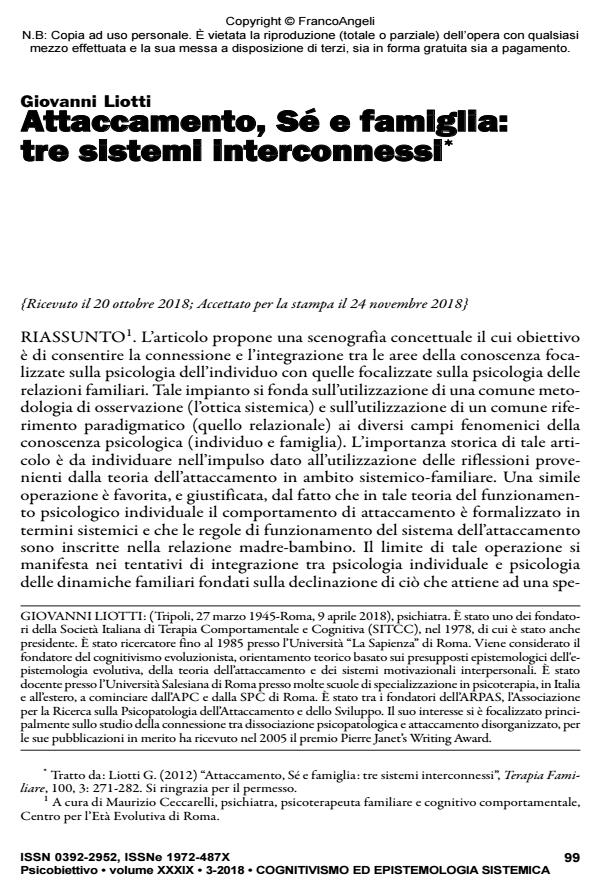Attachment, self and family: three interconnected systems
Journal title PSICOBIETTIVO
Author/s Giovanni Liotti
Publishing Year 2018 Issue 2018/3
Language Italian Pages 12 P. 99-110 File size 119 KB
DOI 10.3280/PSOB2018-003010
DOI is like a bar code for intellectual property: to have more infomation
click here
Below, you can see the article first page
If you want to buy this article in PDF format, you can do it, following the instructions to buy download credits

FrancoAngeli is member of Publishers International Linking Association, Inc (PILA), a not-for-profit association which run the CrossRef service enabling links to and from online scholarly content.
The article advances a conceptual scenography with the aim of connecting and integrating the areas of knowledge focused on the psychology of the individual with those focused on the psychology of family relationships. This system uses a common methodology of observation (the systemic view) and a paradigmatic reference (the relational one) for the different phenomenal fields of psychological knowledge (individual and family). The historical relevance of this article is to be found in the impulse given by the use of reflections evolving from the theory of attachment in a systemic-family context. This operation is favored and justified by the fact that, in the individual psychological functioning theory, the attachment behavior is formalized in systemic terms. Furthermore, the rules of functioning in the attachment system are inscribed in the mother-child relationship. The limits of this approach lie in the attempts to integrate individual psychology and family psychology dynamics which are based on the deterioration of a specific motivational condition (the personal vulnerability that supports the activation of attachment). This declination is expressed through a specific interactive context (the dyadic relationship based on the dynamic attachment/ occurrence) to a grouped relational network (the family). The consecutive development of the author’s thought aims at defining a multiplicity of motivational systems (attachment, care, agonism, cooperation, affiliation), correlated to a variety of interactive contexts in which these systems develop and operate (dyadic, triadic, groups, sociocultural). This offers a theoretical grid that responds in a more appropriate way to the complexity of the operation aimed at integrating the data related to the individual with that pertinent to relational plots. In this complex theoretical framework, the centrality of the reference to the concept of motivational system, understood as the innate tendency of the subject to relate to the world (physical, interpersonal, socio-cultural), allows the author to integrate biology data from the evolutionary field, thus delineating a theory where the human being is a result of biopsychosocial nature. Affirming this enduring combination, both in the construction and in the maintenance of the mind, between the clear biopsychosocial nature of it and the intrinsic relational dimension of that nature, allows the Author to consider the different contexts of therapeutic intervention (individual, group, family, community) as tools of care where the mind is nourished and expressed through the activation and exercise of the different relational contexts. In this perspective, the organization of those instruments in a therapeutic sense, including their possible combination (integrated therapies), can be fully defined only thanks to a negotiation process between therapist and patient, within the specific and always unique relationship between them.
Keywords: Attachment; Self; Family; Motivational System; Consciousness.
Giovanni Liotti, Attaccamento, Sé e famiglia: tre sistemi interconnessi in "PSICOBIETTIVO" 3/2018, pp 99-110, DOI: 10.3280/PSOB2018-003010